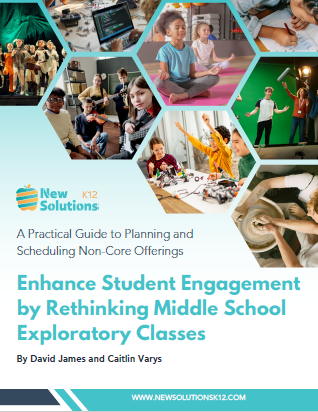
Our Thoughts On
Designing Middle Schools for a New Generation
Meeting the Needs of a New Generation of Learners Requires a New Approach
Middle schools first emerged in the 1960s as a developmentally responsive bridge between childhood and adolescence, designed to build engagement, belonging, and discovery through interdisciplinary teaming, advisories, and exploratory learning. For decades, this middle school model provided an influential framework for supporting young adolescents. Yet, the needs of students—and the demands on middle schools—continue to shift, while the middle school model has remained much the same.
Students today navigate adolescence in an era of social media, constant digital connection, and heightened mental health needs. Middle schoolers are more dissatisfied and disengaged with school than their elementary and high school peers, and many middle schoolers now feel more isolated and less connected to peers and teachers than ever before.
Middle schools today confront stalled post-pandemic recovery, heightened mental health needs, persistent achievement gaps, declining enrollment, tighter budgets, and rising expectations. Simply put, middle schools today face the challenge of addressing greater student needs with a narrower set of tools and resources.

To meet the evolving needs of students, an updated model for middle school is needed—one that leverages the strengths of the traditional middle school design with a reimagined approach that is relevant and impactful for a new generation of students.
Reimagining Middle School to Better Serve a New Generation of Learners
With research-backed, system-level strategies, school and district leaders can build on the strengths of the traditional middle school model to rethink how schools support young adolescents by strengthening core instruction, broadening opportunities for students, and using time and resources more strategically to boost learning and engagement.
1. Raise student achievement by making core instruction core to the schedule.
More time on core instruction leads to greater mastery. However, middle schoolers often get fewer minutes of math and literacy than they did in elementary school—and less than they will again in high school. In addition, planning and collaboration time for grade-level teachers is often focused on student behaviors, classroom routines, and school culture—issues only adjacent to delivering high-quality core instruction. Far fewer middle schools prioritize daily, content-specific planning time for teachers to collaborate with their core content peers and discuss curriculum, lesson plans, and ways to maximize the impact of Tier 1 instruction.
Ample research makes it clear that no schedule model is best, and no schedule by itself will improve student achievement. What can sink student achievement, however, is a lack of time devoted to high-quality instruction. Achievement gains start with making core instruction the non-negotiable center of middle school design.
2. Help students who struggle (with and without disabilities) catch up by offering content-specific intervention classes
In the traditional model, middle schools struggle to carve out time for best practice intervention, leaving students who struggle with limited support. Flex or WIN blocks, unfortunately, do not achieve the structure, consistency, and clear expectations needed for intervention to be effective.
The better route is to structure academic intervention like any other subject being taught as a class. Research is clear that gap-closing middle schools provide academic intervention for math, reading, and writing for students who need it via extra-time, content-specific classes scheduled into the day.
3. Boost student emotional well-being by limiting unstructured time and adding behavioral expertise.
Academic progress for middle schoolers rests on emotional and social foundations. However, despite enormous efforts and focus on the part of middle schools, many students still regularly report feeling anxious or exhibit signs of dysregulation.
Middle schools can work to ensure the social-emotional safety of their students by reducing or removing unstructured time wherever possible, adding a high level of structure to any remaining unstructured time, and proactively addressing problematic behavior with expertise.
4. Enhance student engagement through meaningful voice and choice and by leaning into student passions.
Student engagement is one of the strongest predictors of whether students attend school regularly, participate in class, and succeed academically. Unfortunately, the traditional middle school model often undermines engagement by not providing students with meaningful enough voice and choice.
To build and enhance student engagement, middle schools should prioritize providing a rich set of exploratory and elective classes that tap into student interests, and over which students have some degree of choice in selecting. Even better is to also offer honors or accelerated sections for students in select core subjects to ensure students who crave a higher level of rigor receive it.
5. Operate middle schools more cost-effectively by using more flexible teaming and staffing approaches.
The bedrock of historical middle school design is that core teachers typically teach only one grade level and one subject, which significantly reduces a school’s ability to shift teaching and staffing assignments in response to changes in student enrollment. On top of this, middle school core teachers typically spend the least amount of the school day teaching content relative to their elementary and high school level counterparts. Translated, this means middle schools that use the traditional teaming model are very expensive, often requiring overstaffing relative to enrollment or services to be reduced in times of tight finances.
Middle schools can gain flexibility without giving up the benefits of teaming by using different staffing models, such as having teachers cover multiple grades or subjects, or mixing students across teams for certain classes. These approaches lower costs and make it easier to adjust when enrollment shifts. Schools can also make better use of teachers’ “extra” periods by assigning them to teach an additional content class, offer an elective, or lead targeted intervention classes. Together, these strategies can give middle schools much more flexibility in adapting to shifting enrollment, and even make new or different schedule approaches possible.
What Success Looks Like
One district restructured its middle school schedule to expand time for core instruction by 20%, leading to double-digit gains in reading and math proficiency within two years.
One district overhauled its teaming and staffing model, which saved $1.5 million in staffing, all while maintaining existing classes and programs, and without extending the school day.
One district redesigned its intervention approach, replacing an unstructured flex block with content-specific support classes that cut the number of students below grade level in math in half.
Rethinking Middle School Exploratory Classes to Enhance Student Engagement
A Practical Guide to Planning and Scheduling Non-Core Offerings
Resources
Making Scheduling More Strategic
It’s Time for Strategic Scheduling: How to Design Smarter K–12 Schedules That Are Great for Students, Staff, and the Budget

